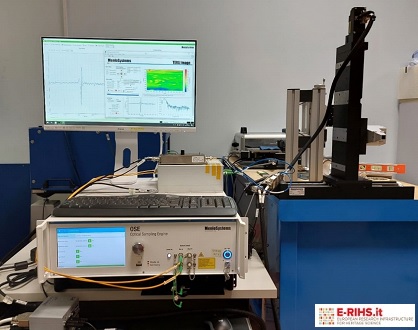
LABORATORY: CNR-ISPC
NAME OF THE INSTRUMENT
Terahertz Time-Domain Imaging Specrometer (THz-TDI):
TeraOSE Menlo Systems
GENERAL DESCRIPTION
Time-domain spectroscopic imaging at Terahertz frequencies (THz-TDI) is a cutting-edge technique among those currently used for the study of Cultural Heritage and provides information on the layer structure and composition of a sample in a completely non-invasive way. THz radiation is indeed non- ionizing and capable of penetrating most non-metallic materials for depths of the order of a few millimeters. It can be used to carry out both transmission and reflection measurements.
THz-TDI measurements in reflection mode carried out along several measurement lines, allow the acquisition of a data cube, which, after adequate data processing, provides information on the sample's surface and subsurface along each of the three spatial sections, i.e., in the (x-y), (x-z), and (y-z) planes.
THz-TDI measurements in transmission mode allow both the generation of two-dimensional images of the sample and the carrying out of spectroscopic analyses aimed at identifying the constituent materials. This kind of analysis can be carried out when the sample's thickness and characteristics allow the transmission of the signal.
Possible applications of THz-TDI include the study of the stratigraphy of decorated artefacts (glazed ceramics, mortars, lacquers, paintings), the identification of preparatory drawings and re-paintings, and optically invisible detachments, cracks or defects, and the characterization of plastic and composite materials.
TECHNICAL DESCRIPTION
The transportable spectrometer TeraOSE by Menlo Systems available through MOLAB allows to carry out both reflection and transmission measurements. This system exploits the principle ofasynchronous optical sampling (ASOPS) thanks to the use of two ultra-fast femtosecond laser sources which are connected to the transmitting and receiving antennas via optical fibres.
The system of generation and acquisition of the THz signal (Optical Sampling Engine, OSE) is compact and integrated in a single unit. It is associated with a two-dimensional scanning system, whose maximum scanning area is 30 x 30 cm2.
The spectrometer has a total weight of 36.5 kg (OSE = 24 kg, PC = 11 kg, splitter box = 1.5 kg), while the scanning system weighs 15 kg. The dimensions of the OSE are: 56 x 45 x 25 cm3.
The nominal spectral window of the system is 4 THz and the scan interval in the time domain is 10 ns. The signal to noise ratio is > 70 dB (with frequency difference = -10 Hz, sampling rate = 10MHz, gain = 106, bandwidth = 1.8 MHz, 1000 averages).
The lateral resolution of the measurement is determined by the size of the THz pulse at the focal point, which is approximately 1.5 mm, and by the step of the scanning system, which cannot be less than 0.1 mm. The in-depth resolution depends on the usable bandwidth of the system and is about 0.5 ps, corresponding to 60 μm (in air).
The maximum depth of analysis is 7.5 mm (in air).
Referent:
Ilaria Catapano ilaria.catapano@cnr.it
